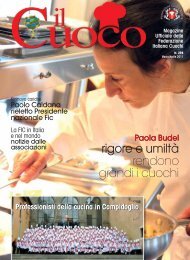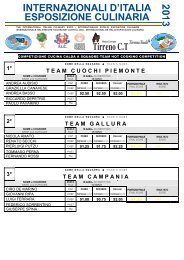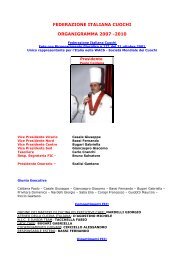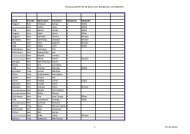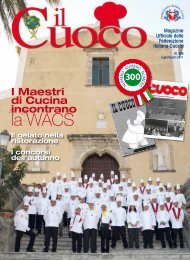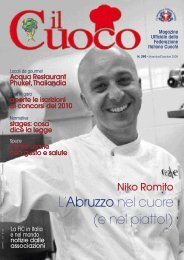N. 291 - Federazione Italiana Cuochi
N. 291 - Federazione Italiana Cuochi
N. 291 - Federazione Italiana Cuochi
You also want an ePaper? Increase the reach of your titles
YUMPU automatically turns print PDFs into web optimized ePapers that Google loves.
ILCUOCOINTERNATIONAL<br />
SEE PAGE 46<br />
FOR THE ITALIAN<br />
TEXT<br />
“Poor” cooking<br />
and quality catering<br />
by Michele D’Agostino<br />
Maestro di cucina and<br />
executive chef, teaching<br />
and gastronomy coordinator for the<br />
Fic Ateneo della Cucina <strong>Italiana</strong><br />
Producingqualityfoodnolongermeansusing<br />
sophisticated products and super-technological<br />
transformations. All you need are excellent<br />
raw materials, links with tradition,<br />
modern cooking methods and attention to retaining<br />
all the nutritional aspects of the food.<br />
The kitchen is a research laboratory and<br />
is often considered a cultural experience<br />
rather than an experience of the palate.<br />
And, in order to stay on the crest of the<br />
wave, for some time chefs have been focusing<br />
on the quality and freshness of ingredients<br />
and on the enhancement of<br />
flavours, seeking new and stimulating<br />
combinations, often to the detriment of traditional<br />
dishes, based on “poor”, local raw<br />
materials. Today, this has once again become<br />
important.<br />
“POOR”, BUT RICH<br />
This type of cuisine is defined as “poor”<br />
because its ingredients are simple and w-<br />
holesome and because it is a cuisine of the<br />
people, organised around dishes made<br />
from what is available according to the d-<br />
ifferent areas of our Country. In this<br />
sense, it is also a typical, traditional cuisine,<br />
linked to original products. But it is also<br />
tasty in the style of “managing as you can”<br />
which does not neglect taste. This is no reason<br />
to consider it “the daughter of a lesser<br />
god”. On the contrary, due to its w-<br />
holesomeness and richness in nutriment,<br />
it is experiencing a rediscovery.<br />
The task of the modern chef does not<br />
end with serving a carefully prepared,<br />
tasty dish, but he must also educate his<br />
client, to whom he will recount, with due<br />
skill, how he transforms his ideas into culinary<br />
creations, demonstrating how the dish<br />
is a great communicator, not eloquent but<br />
at the same time a bearer of highly inventive<br />
ideas. An art which needs attention and<br />
skill must be fed, protected and, above all,<br />
handed down.<br />
THE GUIDE OF<br />
THE QUALITY RESTAURANT<br />
1. The restaurant is well indicated and<br />
in excellent general conditions.<br />
2. The menu, with prices, is displayed<br />
outside the restaurant, has products of<br />
guaranteed authenticity and is offered<br />
to clients together with the wine list.<br />
3. The front-of-house staff are professional,<br />
friendly and efficient.<br />
4. The wine and food on offer in the<br />
restaurant are coherent with the category<br />
to which it belongs and guarantee a variety<br />
of dishes.<br />
5. The restaurant is clean, tidy and well<br />
lit.<br />
6. The toilets are clean and perfectly<br />
maintained.<br />
7. Current food health and safety regulations<br />
are observed in the kitchen.<br />
8. The premises are welcoming and<br />
comfortable in terms of air quality and<br />
acoustics.<br />
9. The bill is divided into items that are<br />
easy to understand and can be paid with<br />
the main means of payment.<br />
10. The restaurant management is attentive<br />
to environmental protection.<br />
F<br />
SEE PAGE 48<br />
FOR THE<br />
ITALIAN TEXT<br />
The NIC<br />
The Italian National Chefs’ team<br />
(NIC), was established in 2004 as an<br />
emanation of the Italian Chefs’ Federation,<br />
which brings together over 20<br />
thousand Italian chefs. It’s structured<br />
into two distinct teams: the National<br />
Major and National Under, made up<br />
of young chefs who could later go on<br />
to join the NIC team. In their respective<br />
categories, both teams take part in<br />
important international culinary competitions<br />
reserved for chefs. Team<br />
manager and the sole contact for all<br />
NIC activities is Chef Fabio Tacchella.<br />
In three years of activity the teams<br />
have won many prizes, medals and acknowledgements<br />
at some of the most<br />
important culinary events of recent<br />
years. Through this success, NIC is<br />
making a significant contribution to<br />
spreading Italian gastronomic culture<br />
and the concept of Made in Italy.<br />
F<br />
SEE PAGE 60<br />
FOR THE ITALIAN TEXT<br />
The light touch<br />
by G. Guadagno,<br />
teacher at the Itp Collegio<br />
Ballerini, Seregno (MB)<br />
A handy list for cooking dedicated to young<br />
trainee chefs. Ten simple rules to be remembered<br />
at all times<br />
1. Cooking. Have a preference for new<br />
cooking systems and try new technologies.<br />
Cooking in a very hot non-stick frying<br />
pan, indispensable for browning well,<br />
may make it possible to totally eliminate<br />
the addition of fat which was indispensable<br />
in traditional pans to stop the food<br />
from sticking. Keep the heat high. Try<br />
steaming: it protects the juices of the food<br />
in the product and prevents the many nutritional<br />
elements from being lost in the<br />
water, especially mineral salts and proteins.<br />
Try cooking in the microwave. Above all,<br />
if something doesn’t usually turn out well<br />
for you (i.e. is not particularly good!)<br />
change system.<br />
2. Freshness. Use very fresh, excellent<br />
quality products. Often, what we eat<br />
does not satisfy the palate and, above all,<br />
does not satisfy us from the psychological<br />
point of view, because it has lost its texture<br />
or flavour. Look for food of an excellent<br />
quality and prepare it in the best<br />
possible way. The food we eat is often im-<br />
80|




